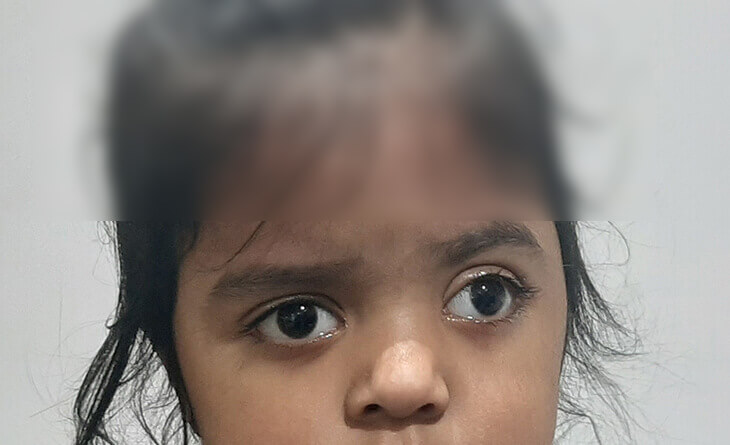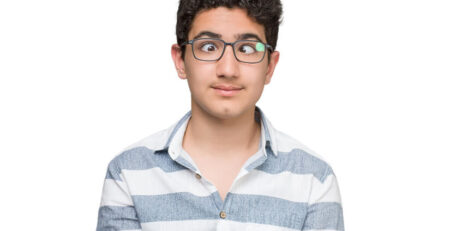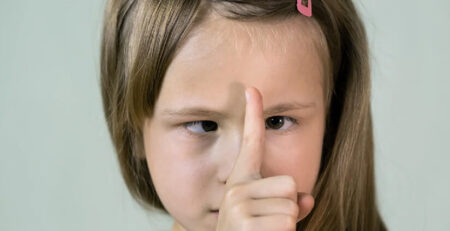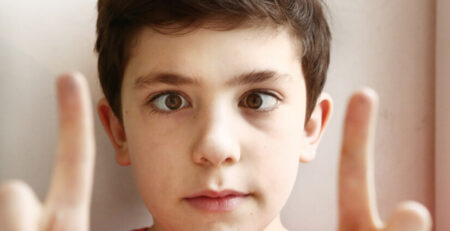What Is Squint, And How Is It Treated?
Have you ever noticed someone whose eyes seem to have a mind of their own, not looking in the same direction at the same time? That’s a classic sign of squint, a condition where the eyes are misaligned, affecting their ability to work together. Squint impacts visual function and can affect a person’s confidence and self-esteem.
But fear not! In this blog, we will dive into the fascinating world of squint, exploring its causes, symptoms, and treatment options.
So, if you are curious about this intriguing eye condition and eager to learn more, keep reading!
What is Squint Eye?
Squint eye, also known as strabismus or crossed eyes, is a condition where the eyes do not align properly and point in different directions. In other words, when one eye looks straight ahead, the other may turn inward, outward, upward, or downward. This misalignment can be constant or intermittent and may affect one or both eyes.
Squint eye can occur in one or both eyes and be constant or intermittent. It can affect people of all ages, including children and adults. Squint eye can cause visual disturbances, including lazy eye, double vision, blurred vision, and reduced depth perception. It can also have social and psychological implications, such as self-consciousness, difficulty with eye contact, and decreased quality of life. However, timely treatment in the form of glasses or the squint surgery procedure can help you to resolve the issue.

Causes of Squint Eye
Squint eye, or strabismus, can be caused by a variety of factors, including:
Muscular Imbalance: The muscles that control the movement of the eyes may not be working properly, causing an imbalance in the eyes’ alignment. This can be due to weak or overactive eye muscles or a problem with the nerves that transmit signals to the muscles.
Refractive Errors: Different kind of refractive errors are responsible for different kinds of squints. A significant difference in the refractive error (i.e., the need for glasses) between the two eyes can lead to a squint eye. When one eye has better vision than the other, the brain may suppress the input from the weaker eye, leading to misalignment.
Similarly, in some forms of refractive error the eye muscles work extra to focus for near, causing inward squinting.
Such squints get corrected by using correct power of glasses.
Genetics: Squint eye can run in families, suggesting a genetic component. If one or both parents have a history of strabismus, their children may be at an increased risk of developing the condition.
Eye Injuries or Trauma: Trauma to the eye muscles or nerves due to injury or surgery can result in squinting the eye.
Poor vision in one eye : Poor vision in one eye can lead to inward or more commonly outward squint, as the non-seeing eye is not able to focus and hence drifts away, causing squint.
Amblyopia: Amblyopia, also known as “lazy eye,” is a condition where the brain suppresses the input from one eye due to poor vision, leading to misalignment of the eyes.
Environmental Factors: Prolonged and excessive use of digital devices, poor visual habits, or environmental factors that affect visual development in early childhood, such as poor lighting or visual stimuli, can also contribute to the development of a squint eye.
The severity of the condition can affect the treatment, and hence squint surgery cost in Delhi.
Types of squints
There are several different types of squint eyes, or strabismus, which are classified based on the direction of misalignment of the eyes. The common types of squints are classified as follows:
1- By the direction of the squinting eye:
- Esotropia: An eye that turns inward towards the nose.
- Exotropia: An eye that turns outward, away from the nose.
- Hypertropia: An eye that turns upwards.
- Hypotropia: An eye that turns downwards.
2- The frequency with which the squint appears
- Constant squint: A squint that is always present.
- Intermittent squint: A squint that comes and goes.
3- When the squint is visible:
- Manifest squint: A squint that is noticeable when the eyes are open, and both eyes are looking.
- Latent squint: A squint only noticeable when one eye is covered or shut.
4- By whether the severity of the squint is the same in all directions or not:
- Concomitant squint: The squint angle (degree) is always the same in whichever direction the eyes glance. This indicates that the two eyes move smoothly but are continually slightly out of alignment, regardless of gaze direction.
- Incomitant squint: The squint angle might change based on the direction of the gaze. For example, the eyes may be well-aligned when gazing in one direction, but the misalignment may be more obvious when looking at another.
Proper diagnosis and classification of the type of squint are important in determining the appropriate treatment approach for squint eyes, like squint surgery in Delhi.
Symptoms of Squint Eye
Symptoms of squint eye, or strabismus, can vary depending on the severity, type, and age of onset. Common symptoms may include:
- Misaligned eyes
- Poor vision
- Double vision
- Poor depth perception
- Eye strain or discomfort
Squint eye can have varying degrees of severity; some individuals may not experience noticeable symptoms. Regular eye examinations by an eye care professional are important, especially in children, to detect and manage squint eyes early to prevent potential long-term complications. Squint surgery procedure helps to overcome the problem.
Treatment for Squint Eyes
The treatment for squint eyes, or strabismus, depends on the type, severity, and underlying cause of the squint and the age of the person affected. Some common treatment options for squint eyes include
Prescription Eyeglasses or Contact Lenses: In some cases, squint eyes may be corrected with prescription eyeglasses or contact lenses, especially if a refractive error, such as nearsightedness, farsightedness, or astigmatism, causes the squint. Correcting the refractive error can help to align the eyes and improve binocular vision.
Patching or Penalisation Therapy: Patching or penalisation therapy is often used in amblyopia or “lazy eye,” which may accompany squint eyes. This involves covering the stronger eye with a patch or blurring its vision with special eye drops or lenses to encourage the weaker eye to develop stronger visual skills and improve visual acuity. This is not a treatment for correcting squint, but a treatment for lazy eye that occurs due to squint.
Vision Therapy: Eye exercises, also known as vision therapy or eye training, are specific exercises or activities that are designed to improve the strength, coordination, and flexibility of the eye muscles, as well as enhance visual skills and performance. Eye exercises are often a non-surgical or adjunctive treatment for certain eye conditions, including strabismus (squint eyes), amblyopia (lazy eye), convergence insufficiency, and other visual problems.
Botox Injections: In some cases, injections of botulinum toxin (Botox) may be used to temporarily weaken or relax specific eye muscles to help align the eyes. This is typically done for certain types of squint eyes, such as those cause dby nerve paralysis, and are expected to improve over some time.
Prisms: Prisms are optical devices that can bend light and change the direction in which light rays enter the eyes. They can help to modify the way images are perceived by the eyes, which can sometimes help improve alignment and reduce double vision associated with squint eyes. Prisms can be incorporated into eyeglasses or other optical devices, such as goggles or patches, and can be prescribed by an ophthalmologist or a qualified eye care professional.
Sometimes doctors may prescribe squint surgery in Delhi.
Squint Surgery
Squint surgery, also known as strabismus surgery, is a surgical procedure that aims to correct the misalignment of the eyes in individuals with squint eyes or strabismus. The surgery involves repositioning or adjusting the length of the eye muscles to align the eyes properly, allowing them to work together as a team and improve binocular vision.
Squint surgery in Delhi is typically performed under general anaesthesia or local anaesthesia, depending upon the age of the patient. The surgeon makes small incisions on the eye’s surface to access the eye muscles. The muscles may be repositioned, tightened, or loosened, depending on the type and severity of the squint. The goal is to achieve proper alignment of the eyes and restore normal eye muscle function.
Squint surgery procedure can be highly successful in realigning the eyes and improving the appearance and function of the eyes.
The recovery period after squint surgery in Delhi varies depending on the individual and the extent of the surgery. Most people experience some discomfort, swelling, and redness in the eyes after surgery, which typically resolves within a few days to a week. Eye drops or ointments may be prescribed to aid in healing and prevent infection. Complete recovery may take few weeks. During this time, the person may need to avoid strenuous activities, protect the eyes from dust, smoke, and bright sunlight, and follow the surgeon’s post-operative instructions.
The squint can sometimes recur after a few years, even after undergoing initial treatment, including surgery. If squint does recur after initial treatment, a repeat surgery may be necessary.
All these factors can affect the squint surgery cost in Delhi.
Conclusion!
Squint, also known as strabismus, is a condition that affects the alignment of the eyes and can cause visual disturbances if left untreated. However, with proper diagnosis and intervention, squint can be effectively managed. If you or your loved one is experiencing symptoms of squint, it’s important to consult with a qualified eye care professional who can provide expert evaluation and personalised treatment options, like squint surgery in Delhi.
Don’t let squint affect your vision and quality of life. Take the first step towards better eye health by scheduling a consultation with Dr Anisha Gupta today!





